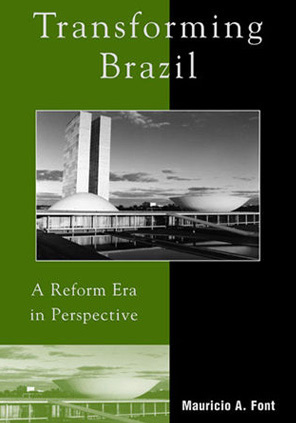Transforming Brazil: An Era of Reform in Perspective
Rowman & Littlefield, 2003
Author: Mauricio Font
Transforming Brazil explores the complex web of policies, ideas, institutions, social forces, and political actors behind recent Brazilian reforms. By placing them in a broader analytical framework, it sets the backdrop for a better understanding of the character, timing, and sequencing of the reform process. The focus is on the complex reform efforts during the post-1985 democratization era. The introductory chapters place Brazilian reform in comparative perspective and explore theories and accounts of the political, social and institutional context in which the reforms took place, the political process leading up to reforms, and the actors that influenced them, including elites, business, government, institutions and interest groups. The analysis of stabilization and economic liberalization weaves in accounts of policies and of Fernando Henrique Cardoso’s election as president in 1994 and his re-election in 1998. The detailed study of privatization, deregulation, trade liberalization and opening of the economy, state and administrative reform, agrarian reform, changes in social security system, fiscal reforms, and related reforms during the eight years of the Cardoso government show that they amount to a turning point in Brazilian politics, even if several reforms remain incomplete. The analysis also points to factors shaping the reform process and the relationship between the reforms and vulnerability to external financial crises and shocks.
Transforming Brazil explores the rise and flux of a restructured industrial economy, with expanding service and agricultural sectors. It traces social and economic indicators from the 70’s to present, highlighting spatial and social differences. The chapter on social policy and collective action traces the history of the labor and landless movements. More broadly, it sheds light on how civil society and collective action influence agrarian reform and other reform process. The analysis also clarifies the nature of elite and popular support for the reform process. Business’ cordial, tentative and sometimes accusatory relationship with the reforming government, leading up to and throughout the post-1994 reform process, is analyzed, together with business’ newfound interest in social policy and philanthropy.
The volume assesses the extent to which this reform process represents a new development model or strategy and its relationship to democratization. The reform process has dismantled the statist regime in place since the Vargas’ era and sets the stage for a new, liberalizing one inspired by Social Democratic ideas. The impact of government efforts on social, economic, and human development is assessed. This study closes with a thoughtful discussion of the relationship between reform and democracy and advances a structural realignment model to highlight the centrality of political processes in reform and development.
Table of Contents:
• A Reform Era in Perspective
• From Stabilization to Economic Liberalization
• State in Transition
• Social Development and Collective Action
• Elites and Reform
• Toward a New Development Strategy
• Democracy, Realignment, and Reform
• Appendix A Stabilization Plans after 1985
• Appendix B Fiscal Adjustment Packages
• Appendix C Planning and Social Development
• Appendix D Statistical Trends
• Appendix E Regional Differences

